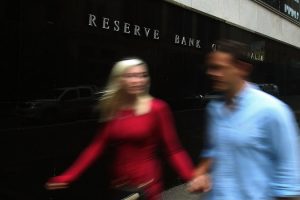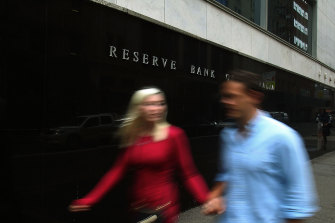The case for an interest rate rise is clear. The RBA must act now

The Reserve Bank must increase interest rates on Tuesday to keep inflation in check.
Figures released last week showing annual consumer price inflation at a two-decade high of 5.1 per cent, and other indicators that price pressures continue to build, mean there is an overwhelming case to lift the cash rate target from the pandemic emergency low of 0.1 per cent. A gradual return to more-normal interest rate settings is in Australia’s interests.
It is more than 11 years since the Reserve Bank last lifted official interest rates. Credit:Ben Rushton
The Reserve should begin that process now or risk being forced into more aggressive increases to combat inflation down the track. The central bank’s board will have understandable concerns about moving the cash rate during a federal election campaign. It is more than 11 years since the last official interest rate increase in Australia and many people with a mortgage have never had to confront the prospect of higher borrowing costs.
But having official interest rates near zero is no longer justified when unemployment is at 4 per cent and inflation over 5 per cent (and rising). History shows that the longer high inflation persists, the more consumer expectations of inflation rise and that makes it even harder to get price growth back down again. “The RBA no longer has time on its side and should move now and do so decisively,” says AMP chief economist Dr Shane Oliver.
Given the strong arguments supporting a lift in interest rates, and the persistent debate about household cost-of-living pressures, the public expects action. If the RBA fails to increase rates now, many will assume the delay is due to the election, and that will damage the bank’s hard-won reputation for independence.
The RBA asserted that independence in November 2007 when its board opted to lift rates during a federal election campaign. It is crucial for the central bank’s standing that the current board do that again on Tuesday.
The RBA may opt for a modest 0.15 percentage point increase, taking the official cash rate to 0.25 per cent, although a 0.4 percentage point rise to 0.5 per cent would signal a strong resolve to anchor inflation expectations.
Global factors have underpinned Australia’s rise in inflation, especially supply chain disruptions caused by the pandemic and the Russian invasion of Ukraine, which pushed up commodity prices.
But government support for households during the pandemic has also contributed to inflationary pressure. Pre-election largesse targeted at voters by the Morrison government in the March federal budget, and supported by Labor, is pouring fuel on the inflation fire.
It means the RBA looks likely to be lifting official interest rates in a bid to curb inflation at the same time federal spending helps stoke consumer spending and so puts upward pressure on prices. This unfortunate contradiction between fiscal policy and monetary policy is now playing out in the middle of an election campaign.
Like central banks around the world, the RBA faces a delicate policy challenge. Higher interest rates are needed to keep a lid on inflation, but if the monetary-policy brakes are pushed too hard this could snuff out the economy’s recovery from the disruptions of COVID-19.
Australia is well placed overall to cope with higher interest rates. But debt as a share of household income has risen sharply since the previous phase of interest rate increases, which began in 2009, and that has made borrowers much more sensitive to rate rises. Small increases are likely to be far more potent than in the past.
Much will depend on how the generation of borrowers who have never experienced a period of interest rate increases react to higher mortgage costs. The risk that higher rates cause an accidental recession is very real.
The RBA must act now but proceed with extreme caution.
Gay Alcorn sends a newsletter to subscribers each week. Sign up to receive her Note from the Editor.
Most Viewed in Business
From our partners
Source: Read Full Article

